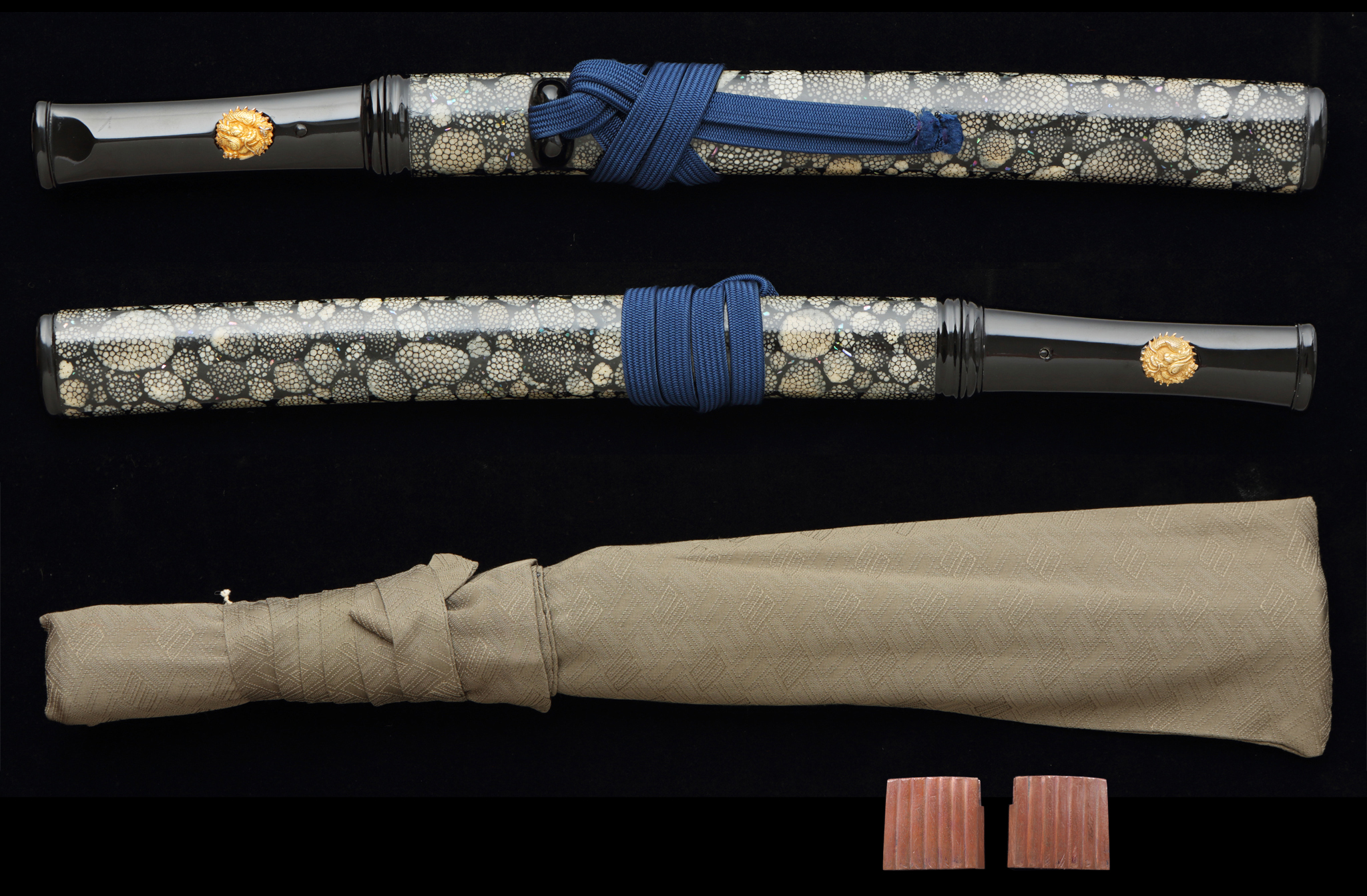[ Feature ]
Form : Hira-zukuri. Iori-mune. Mihaba and kasane are both ordinal. A little sori attached. Tanto form.
Nakago : Ubu. Yasurimes are kiri. Saki is kurijiri. One hole.
Jigane : Itame-hada. Mokume-hada mixed. Nagare-gokoro observed. Jinie attached. Chikei and shirake-utsuri appeared. Jifu shown.
Hamon : Ô-gunome-midare. Ashis and yos appeared. Togari-bas mixed. Nie attached. Kinsujis and sunagashis appeared frequently. Mune-yaki(tempering) done.
Boushi : It runs in midare-komi, then becomes jizo-boushi. Saki has a little haki-kake.
Togi-dashi-zame aogai-chirashi aikuchi koshirae ; Menuki : Ryu(dragon)-zu( gin(silver)-ji, kin-tokin(gold gilding))); Tsuka : kuro-ro-iro nuri
The existence of swordsmith in Mino province is known from earlier period.
In the code tiltled "Engi-shiki", they contributed as tachi creators.
The documents showed that the wealth man of Aohaka ordered the swordsmith Tofuji to copy Minamoto family's succeeded tachi "Hige-kiri".
In the book titled "Kanchi-in Hon-myo zukushi", there are the names Sensui and Nagahaka as the swordsmith of Mino province.
It was regarded that Sensui was the son of Shigehiro Yamato-Senju-in swordsmith. It showed that the annexation of Ko-senju-in to Mino was so old.
However, the remaining swords which back to before end of Kamakura period was seldom seen. Kaneuji and Kaneshige, who worked end of Kamakura period, were only proofed by actual remaining swords. Current swords study consider the Mino-den school occurred and developed after end of Kamakura period.
Early Mino-den : the swords created from end of Kamakura period through Nan-boku-cho period. The main swordsmith were SHIZU Kaneuji, who moved from Yamato province, then became the pupil of So-shu Masamune and Kaneshige who moved from Tsruga of Echizen province. In general, it can be said that they have jigane of Soshu style and Yamato-den mixed.
Middle Mino-den : the swords created from Nanboku-cho (e.g. Enbun, or Jo-ji) to the very beginning of Muromachi period. The main style of sword was represented by the name of Naoe Shizu. Many swords which attributed to them are the swords with no signature and with suriage. Since the orignal swords got shortend (e.g. suriage) later so that the exact timing of creation is not clear. As the feature, they have stronger masa-tone, with shirake, nie-deki rather with nioi, bigger hamon, and significant pointed gunomes.
Late Mino-den : it started from Muromachi period. Actually, big leap of Mino-den, both number of swordsmith and swords, started middle of Muromachi period. The main place was Seki. The school tradition was succeeded in Akasaka and others as well.
As historical back ground, SAITO family (e.g. Toshinaga) encouraged to create the swords from the end of Nan-boku-cho period to Muromachi period (e.g. Ô-ei), it made the flourish of main swordsmith groups of Seki-shichi-ryu. It prospered so much that called "Mino-sen-ken (one thousand wordsmith)
ZENJÔ Kaneyoshi, Izumi-no-kami Kanesada and Magoroku Kanemoto were so famous. End of Muromachi period : The quality of irons and swords getting worse but
practicability with high cutting edge met the demand of Sengoku era. They won to get the reliance of Samoüraîs. The swords spread all over the Japan. Many of them were invited to create the swords in other places. The swords which made during these periods, generally called "Sue-seki". They were going to be hired by big clans in Toyotomi-Tokugawa era, became the ancestors of Shinto-swordsmith. The Mino-den school had strong influence on Shinto-period.
The sword is attributed to Sue-zeki in the Hozon Touken paper of NBTHK issued in Heisei 19(2007)
[ Condition ] It is possible to maitain and appreciate as current status. There are tiny chips at ha-machi and kissaki.




